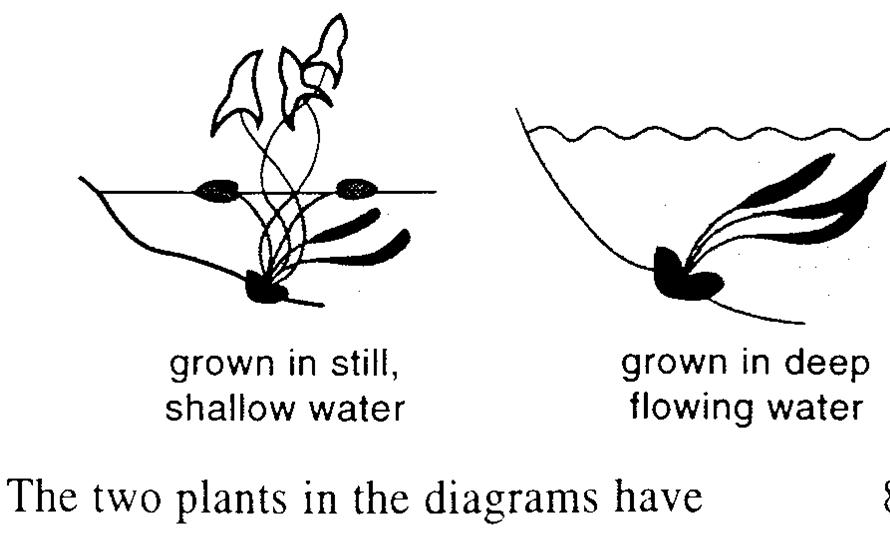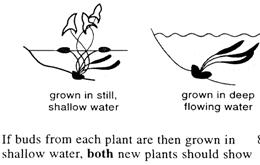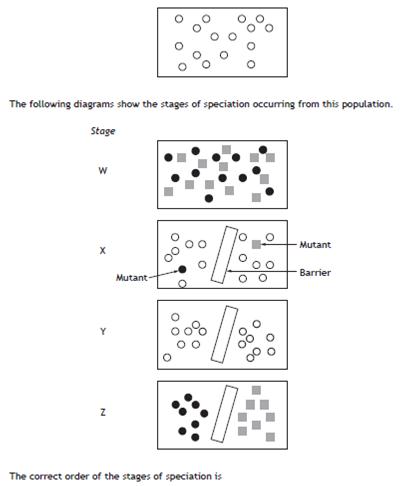| 1. | Which of the following is an example of natural selection? | |
| A. | Increased milk yield in dairy cattle | |
| B. | Industrial melanism in Peppered Moths | |
| C. | Insulin production by bacteria | |
| D. | Insertion of DNA into a chromosome | |
| 2. | The Peppered Moth is found in two distinct forms. One form is dark coloured and the other is light coloured. The moths rest on the trunks of trees. Pale coloured tree-trunks in an area were darkened by pollution. What would happen to the numbers of the two forms of the Peppered Moth in that area? | |
| A. | The numbers of each form would increase. | |
| B. | The dark form would increase and the light form decrease | |
| C. | The numbers of each form would decrease | |
| D. | The light form would increase and the dark form decrease | |
| 3. | The speckled form of the peppered moth is adapated to | |
| A. | cold weather | |
| B. | food shortage | |
| C. | avoid disease | |
| D. | avoid predation | |
| 4. | The factors which prevent the survival of all offspring include | |
| A. | predation and disease | |
| B. | abundant food and shelter | |
| C. | climate and absence of predators | |
| D. | absence of disease and abundant food | |
| 5. | The offspring of a pair of mice are not genetically identical because they | |
| A. | grow up in the same environment | |
| B. | have the same parents | |
| C. | are produced by sexual reproduction | |
| D. | have different phenotypes | |
| 6. | Natural selection is a process in which | |
| A. | differently adapted organisms survive equally well | |
| B. | the best adapted varieties survive and the others become extinct | |
| C. | different environments are formed over millions of years | |
| D. | all varieties survive to breed | |
| 7. | Natural selection | |
| A. | favours better adapted organisms | |
| B. | causes variation in a species | |
| C. | allows sexual reproduction in a species | |
| D. | does not affect evolution | |
| 8. | The two influences on the phenotype of an organism are | |
| A. | environment and adaptation | |
| B. | genotype and adaptation | |
| C. | genotype and environment | |
| D. | environment and habitat | |
| 9. | Human identical twins can have different body weights. This could be because they have different | |
| A. | genotypes | |
| B. | parents | |
| C. | diets | |
| D. | brothers and sisters | |
| 10. | An example of a phenotype which can be influenced by environment after completion of growth is | |
| A. | eye colour | |
| B. | skin colour | |
| C. | blood group | |
| D. | tongue rolling | |
| 11. | Which experimental procedure would best show that environment can affect plant growth? | |
| A. | grow genetically identical plants in different environments | |
| B. | grow genetically different plants in different environments | |
| C. | grow genetically identical plants in identical environments | |
| D. | grow genetically different plants in different environments | |
| 12. | Changes in the phenotype caused by the environment are not significant in evolution of new species because | |
| A. | the changes cannot be passed onto the offspring | |
| B. | offspring inherit them | |
| C. | they are genetic changes | |
| D. | the environment may change | |
| 13. | The list gives events in the evolution of cichlid fish species in lake Victoria
|
||
| A. | 4, 3, 2, 1 | ||
| B. | 3, 4, 1, 2 | ||
| C. | 1, 2, 3, 4 | ||
| D. | 3, 4, 2, 1 | ||
| 14. | Genetically identical plants of the arrowhead plant species, shown in the diagram below, were raised in different situations. One was grown i still, shallow water, the other in deep, fast flowing water. After full development, the two plants differed as shown below.
|
||
| A. | different genotypes and were raised in the same environment | ||
| B. | the same genotype and were raised in the same environment | ||
| C. | the same genotype, but different phenotypes | ||
| D. | different genotypes and different phenotypes | ||
| 15. | Genetically identical plants of the arrowhead plant species, shown in the diagram below, were raised in different situations. One was grown i still, shallow water, the other in deep, fast flowing water. After full development, the two plants differed as shown below.
|
||
| A. | the phenotypes of their parents | ||
| B. | changed phenotypes | ||
| C. | different phenotypes | ||
| D. | the same phenotype | ||
| 16. | The graph below shows the average number of peppered moths in a woodland in June of each year over a 10 year period.
|
||
| A. | increase in dark moths and decrease in light moths | ||
| B. | decrease in dark moths and increase in light moths | ||
| C. | increase in dark moths and increase in light moths | ||
| D. | decrease in dark moths and decrease in light moths | ||
| 17. | Natural selection allowed melanic moths to survive in industrial areas because | |
| A. | the tree trunks were light coloured | |
| B. | they were camouflaged well | |
| C. | robins ate more of them | |
| D. | speckled moths bred with them | |
| 18. | The two varieties of peppered moth have not become two species because | |
| A. | speckled moths do not occur in polluted areas | |
| B. | speckled moths do not breed with melanic moths | |
| C. | the two varieties still interbreed regularly with each other | |
| D. | melanic moths are sterile | |
| 19. | The diagram below represents a population of animals.
|
||
| A. | z, w, x, y | ||
| B. | z, x, w, y | ||
| C. | y, x, z, w | ||
| D. | y, z, x, w | ||






